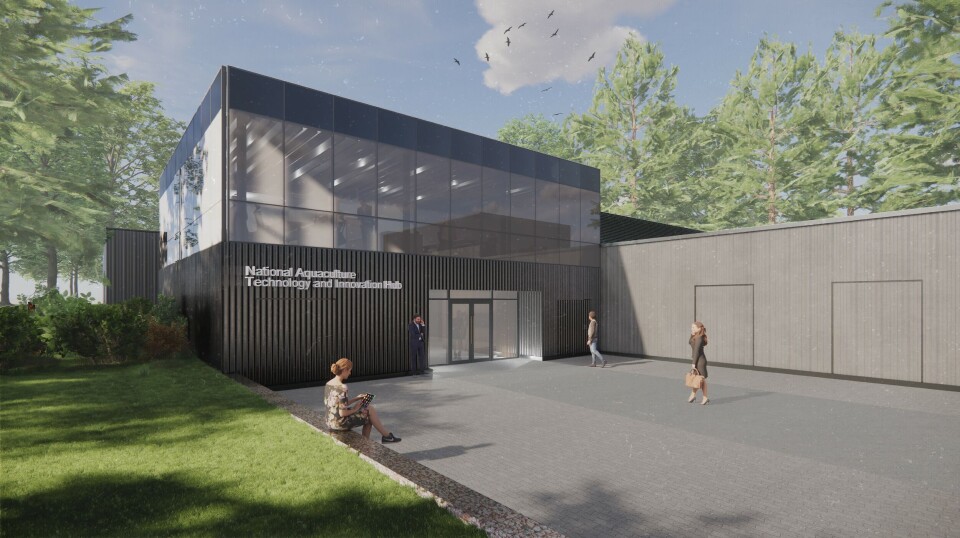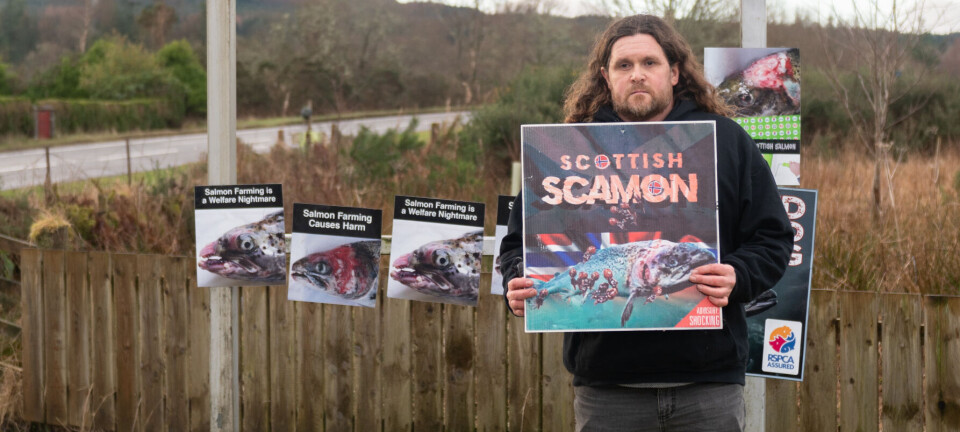LandbasedAQ.com

Steel signing marks a milestone for Scotland's world-class aquaculture hub
The UK government’s Secretary of State for Scotland, Ian Murray, has said a new aquaculture research facility at the University of Stirling’s Institute of Aquaculture (IoA) will boost productivity, improve sustainability, and create jobs.
Murray said the facility, funded primarily by the UK government through the Stirling and Clackmannanshire City Region Deal also involving the Scottish Government and councils, was “a great example of collaboration”.
A “steel signing” event today marked the beginning of the final phase of construction of the facility at the campus.
The pioneering centre to be known as the National Aquaculture Technology and Innovation Hub (NATIH) will drive the UK’s ambition to be a world leader in modern aquaculture practice.
Visiting politicians and senior university leaders signed the steel structure, and a plaque which will be hung in NATIH after it opens next year.
£18m funding
The state-of-the-art facility is funded by £17 million from the City Region Deal, as well as a £1 million grant from the Wolfson Foundation, a UK charity focused on education and research.
NATIH will be fully integrated into the IoA, which already operates a large-scale marine facility at Machrihanish in Kintyre and a freshwater flow-through facility at Buckieburn, around seven miles from the university’s main campus, for salmonids.
IoA head Professor Simon MacKenzie said: “Our vision is to tackle global problems of food security, hunger and sustainability through aquaculture.
“The new National Aquaculture Technology and Innovation Hub will help us build on our international reputation for world-class research, teaching, technological innovation and consultancy in aquaculture, supporting growth in the production of aquatic food for human consumption, contributing to global food security while reducing the impact on natural resources.”

NATIH will have both recirculating aquaculture system (RAS) and flow-through facilities, as well as a quarantine area.
Temperature control
“Think about it as basically two installations. One of those installations is a flow-through disease challenge unit which is of course biosecure, which is in the building but separate to the rest of the installations,” explained MacKenzie.
“And in the other installation there are eight different CT (controlled temperature) rooms. And each one of those rooms has a different RAS installation.”
The temperature control and the independent RAS facilities will enable a broader range of research.
“The CT rooms can run from 4 degrees to 32 degrees. So, you have the capability to grow pretty much any freshwater aquatic organism,” said MacKenzie. “NATIH really takes us to another level in terms of environmental control, and what you can do in terms of controlling across all those rooms and that type of experimentation.
Tilapia and catfish
“We’ve not had a modern tropical fish facility for quite a long time, and NATIH will allow work with tilapia, catfish, etc. It brings us back up to speed in terms of tropical aquaculture in Southeast Asia, where we do a lot of work.
“The Institute of Aquaculture has always worked on a global scale, so we have students from many different countries and what NATIH allows us to do is get back to supporting them working with species that they’re doing in their own countries.”
The water for NATIH is from the Scottish Water mains supply.
“We're re-treating that water to get it to aquaculture grade,” explained MacKenzie. “We’ve got some ultra filtration systems so they’re sitting in the front end, which is removing aluminium, etc.”
Disease challenge
Water discharged from the disease challenge unit will be treated to ensure it is safe for the environment.
“We have a fairly intricate effluent treatment system in there. It has three different levels of sterilisation and cleaning, so we’re confident we can deal with whatever we’re pushing through there,” said MacKenzie. “We worked on that with Scottish Water. It’s all been agreed and certified.”
The IoA hasn’t had a disease challenge facility for a little over 10 years, said MacKenzie, “so that brings us back into that style of work as well, which is fantastic, a huge step forward”.
Hands-on experience
NATIH will improve teaching – which ranges from outreach to local schools to PhD work - by allowing more hands-on work for students.
MacKenzie believes NATIH will be among the world’s top research facilities because of its flexibility and state-of-the-art sensors and equipment.
“If you think about that in terms of modernity, in terms of what we can do for data flow and what we can do in terms of cameras and how we can change those systems around in each room, that’s really a different level.
“We have multiple data feeds in every room, so you're real-time monitoring the whole way through - what you might call precision aquaculture. We’ll be able to take environmental data and behavioural data in real time, with a full sensor complement in each tank, so it’s really exciting because it brings in that big data part of what’s happening in aquaculture.”
Extra capacity
Although the IoA already has salmonid research facilities at Buckieburn and Machrihanish, MacKenzie says NATIH will provide extra capacity to do research for the salmon sector.
“What it certainly brings is that very fine control in the freshwater stage,” he said. “Because of the configuration of the different RAS systems it also gives you different experimental capacities so you can imagine if you were working in the largest room - which is six RAS systems all with triplicate 500-litre tanks - you can do incremental different temperatures, you can run them with CO2, you can bring oxygen down, you can do a lot of different things in those spaces. From an experimental viewpoint, there’s significantly enhanced creativity there.”
NATIH will be a magnet for students, said MacKenzie, and training in the unit may also help address a skills shortage in land-based fish farming, while inculcating trainees in the importance of fish welfare.
Optimising welfare
“We need to be able to optimise animal welfare in our installations no matter what we're doing, whether it’s commercial production or research, it all must aim in that direction. NATIH provides the facilities to be able to train in that [welfare] space, to make people aware of that space, what can we do better, etc. I think that’s really important.”
While the IoA already has a vision for how NATIH can be used, it is open to suggestions. NATIH is, after all, a hub.
“This is about talking to the global aquaculture community, about sharing ideas and communicating ideas. We’re certainly not saying that we’ve got all the answers, and the doors are open to be having those conversations,” concluded MacKenzie.























































